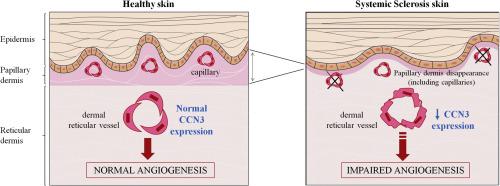Journal of Investigative Dermatology ( IF 6.5 ) Pub Date : 2020-01-16 , DOI: 10.1016/j.jid.2019.11.026 Pauline Henrot 1 , François Moisan 2 , Paôline Laurent 3 , Pauline Manicki 4 , Priscilla Kaulanjan-Checkmodine 2 , Valérie Jolivel 3 , Hamid Reza Rezvani 5 , Vaianu Leroy 6 , François Picard 7 , Carine Boulon 8 , Thierry Schaeverbeke 9 , Julien Seneschal 5 , Estibaliz Lazaro 10 , Alain Taïeb 5 , Marie-Elise Truchetet 4 , Muriel Cario 5

|
Systemic sclerosis (SSc) is a rare and severe connective tissue disease combining autoimmune and vasculopathy features, ultimately leading to organ fibrosis. Impaired angiogenesis is an often silent and life-threatening complication of the disease. We hypothesize that CCN3, a member of the CCN family of extracellular matrix proteins, which is an antagonist of the profibrotic protein CCN2 as well as a proangiogenic factor, is implicated in SSc pathophysiology. We performed skin biopsies on 26 patients with SSc, both in fibrotic and nonfibrotic areas for 17 patients, and collected 18 healthy control skin specimens for immunohistochemistry and cell culture. Histological analysis of nonfibrotic and fibrotic SSc skin shows a systemic decrease of papillary dermis surface as well as disappearance of capillaries. CCN3 expression is systematically decreased in the dermis of patients with SSc compared with healthy controls, particularly in dermal blood vessels. Moreover, CCN3 is decreased in vitro in endothelial cells from patients with SSc. We show that CCN3 is essential for endothelial cell migration and angiogenesis in vitro. In conclusion, CCN3 may represent a promising therapeutic target for patients with SSc presenting with vascular involvement.
中文翻译:

系统性硬化内皮细胞中CCN3的减少有助于血管新生。
系统性硬化症(SSc)是一种罕见的严重结缔组织疾病,结合了自身免疫和血管病变特征,最终导致器官纤维化。血管生成受损通常是该疾病的沉默和威胁生命的并发症。我们假设CCN3是细胞外基质蛋白CCN家族的成员,它是促纤维化蛋白CCN2和促血管生成因子的拮抗剂,与SSc病理生理学有关。我们对26例SSc病人的纤维化和非纤维化区域的17例患者进行了皮肤活检,并收集了18例健康的对照皮肤样本进行免疫组织化学和细胞培养。非纤维化和纤维化SSc皮肤的组织学分析显示乳头状真皮表面系统性减少以及毛细血管消失。与健康对照组相比,SSc患者的真皮中CCN3表达系统性降低,尤其是在真皮血管中。此外,在体外,来自SSc患者的内皮细胞中的CCN3减少。我们显示,CCN3对于体外内皮细胞迁移和血管生成至关重要。总之,对于伴有血管受累的SSc患者,CCN3可能代表了有希望的治疗靶标。


























 京公网安备 11010802027423号
京公网安备 11010802027423号